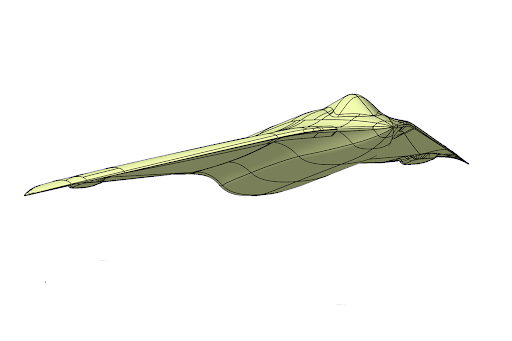
DARPA plans to launch a program to fly an X-plane designed around active flow control with the award of contracts to conduct an extended conceptual design phase.
Three contracts could be awarded beginning as early as this week.
The Pentagon advanced research agency plans to fly a large-scale manned or unmanned demonstrator in mid-fiscal 2024 under the Control of Revolutionary Aircraft with Novel Effectors (CRANE) program.
Active flow control (AFC) involves adding energy into the boundary layer to maintain, recover or improve vehicle performance. Fluidic or plasma actuators can replace conventional flight controls, reduce observability, enhance efficiency, increase maneuverability or achieve other benefits.
Previous applications of AFC include boundary layer control (BLC) using wing blowing to reduce the landing speed of naval aircraft such as the Dassault Etendard IV, Hawker Siddeley Buccaneer and North American RA-5C Vigilante.
But previous uses have involved adding AFC to an already frozen designs to fix problems. BLC was added to the Lockheed F-104 during development to reduce landing speed. AFC was flight tested on the Bell XV-15 tiltrotor to reduce rotor downloads on the wing and on the Lockheed Martin F-16 to reduce loads on the ventral strakes from the wake shed by a targeting pod.
More recently subscale AFC demonstrators have flown in the U.S. and UK, while Boeing and NASA conducted full-scale flight tests of a 757 with a vertical tail that used AFC to increase rudder effectiveness, potentially enabling a smaller, lower-drag tail.
The goal of CRANE is to demonstrate the benefit in a clean-sheet aircraft that incorporates AFC as the primary design consideration. DARPA is looking for novel configurations for a manned or unmanned X-plane weighing between 1,000 lb. and 10,000 lb. and capable of high subsonic speed.
“We are trying to get back into the pure X-plane experimental realm,” said Alexander Walan, DARPA program manager. “We are not looking to do a prototype or something that looks like an operational airplane, but we are looking for high-risk, high-payoff ideas.”
Rather than specify what it is seeking from CRANE, “we said we want novel planforms and geometries, and then you industry can show us what that airplane can do that is different,” he said. “The X-plane may be heavier than a relevant airplane. We may have dual control surfaces at first. But what we want to do is push the envelope and quantify the potential benefit for a transition airplane down the road.”
In the extended, one-year Phase 0 of CRANE, each contractor will design multiple different concepts to explore the trade space for AFC-enabled vehicles. “This time next year we’ll start downselecting from multiple contractors, multiple ideas, to one or more that will go forward to a preliminary design review [PDR],” he told the American Institute of Aeronautics and Astronautics Aviation event on June 16.
“We asked folks to start with multiple configurations with different benefits. Three months into Phase 0 we’ll probably have a downselect from three or four ideas per contractor to one or two so we can focus,” he said. In terms of performance metrics for CRANE “we’re looking at increases in efficiency, maneuverability, takeoff-and-landing performance and weight.”
After the PDR at the end of the nine-month Phase 1, DARPA plans to downselect to a single contractor for detail design in the year-long Phase 2. A critical design review and go/no-go decision on Phase 3 to build and fly the X-plane is planned for mid-fiscal 2023.
In addition to conceptual design, contractors in Phase 0 are expected to perform risk-reduction work including wind-tunnel and component testing and potentially subscale flight tests, largely focused on AFC actuators. Ancillary studies also are planned to identify other potential AFC benefits.





